55+ Surprising distracted driving statistics and facts for 2025
Did you know that texting while driving gives the driver the same response time as a person who has had four beers in a single hour?
By Geotab Team
Jun 3, 2025

Key Insights
- Distracted drivers killed 3,275 people in motor vehicle crashes in 2023.
- Every 10% increase in distracted driving kills over 420 people and costs the economy $4 billion every year.
- Gen Z and Millennials (ages 16-45) account for 72% of all distracted driving violations.
- Distracted driving violations grew by 48% in the first six months of 2024.
- In 2023, drivers spent an average of 1 minute and 38 seconds per hour handling their phones while driving.
Distracted driving caused over 3,000 fatal crashes in 2023, and the problem is only getting worse.
Staying informed on distracted driving statistics is key to protecting your drivers, your fleet and the communities you serve. In this post, we’ll break down the latest data and show how distraction impacts safety, performance and cost, plus practical steps to help prevent it.
With insights from over 4 million connected vehicles, Geotab gives fleets the tools to spot risky driving, improve driver behavior and build a safer operation.
What is distracted driving?
Distracted driving is any activity that takes your attention away from driving, even for a second. Small actions like changing the radio station or checking a map can be dangerous, since they take your eyes off the road.
The CDC identifies three main types of distraction when it comes to driving: manual, visual and cognitive:
Types of distracted driving | ||
|---|---|---|
Manual | Visual | Cognitive |
Taking your hands off the wheel | Taking your eyes off the road | Thinking about something else while driving |
These types of distractions can come from many activities. You are considered a distracted driver if you do any of the following behind the wheel:
- Drowsy driving
- Drive under the influence of alcohol, drugs or medication
- Eat or drink
- Talk with people in your car or on the phone (even hands-free)
- Text, scroll or search on your phone
- Apply makeup
- Play with the radio or navigation system
- Smoke or vape
- Reach for something on the floor
- Look at maps or read directions
- Aggressive driving
For fleet operators, distracted driving isn’t just a safety concern — it’s a serious business risk. It can lead to injuries, vehicle damage, rising insurance costs and costly delays. Preventing it helps protect your team and keep operations running smoothly.
To address distracted driving in your fleet, you’ll need to understand how widespread the issue is and what the latest data shows.
Distracted driving facts and trends
The dangers of distracted driving continue to impact both personal and commercial drivers. Whether behind the wheel of a family car or a work vehicle, even a quick lapse in focus can lead to serious consequences.
From increased collision rates and rising insurance claims to loss of life, the cost of distracted driving is high. The following road crash statistics highlight just how widespread and costly distracted driving has become.
1. Distraction-related collisions caused 3,275 deaths and another 324,819 injuries in 2023.1
2. Five percent of all drivers involved in fatal traffic collisions in 2023 were reported as distracted at the time of the collisions.1
3. In 2023, there were about 600 nonoccupants (pedestrians, pedalcyclists and others) killed in distraction-affected traffic collisions.1
4. Every 10% increase in distracted driving kills over 420 people and costs the economy $4 billion every year.2
5. Distracted driving violations grew by 48% in the first six months from 2023 to 2024.3
6. Gen Z and Millennials (ages 16-45) account for 72% of all distracted driving violations, making them the largest age groups responsible for these infractions.3
7. Males (ages 16-45) commit approximately 59% of distracted driving infractions.3
8. The share of vehicles insurance companies deemed totaled in collisions reached an all-time high of 27% in 2023, rising from 19% in 2018. This includes collisions from distracted driving.3
9. In 2023, distraction-affected traffic collisions injured an estimated 324,819 people.1
10. Distraction-affected injury collisions totalled an estimated 222,396 in 2023.1
11. When considering quality-of-life valuations, distracted-driving collisions caused $395 billion in societal harm in the United States in 2019.1
12. Over 91% of distracted and aggressive drivers live in metropolitan areas, which suggests a higher prevalence of this behavior in urban settings.4, 25
13. According to a recent study, 96% of people have witnessed road rage.5, 25
14. In 2024, nearly 50% of Americans reported that they perceived people in their communities as driving less safely compared to five years previously.6, 25
Distracted driving accidents by state
Distracted driving is a nationwide issue, but some states see significantly more incidents than others. When examining these trends, it's also important to factor in specific trucking statistics related to accidents.
Here are some facts that shine a light on states that have the highest and lowest rates of distracted driving:
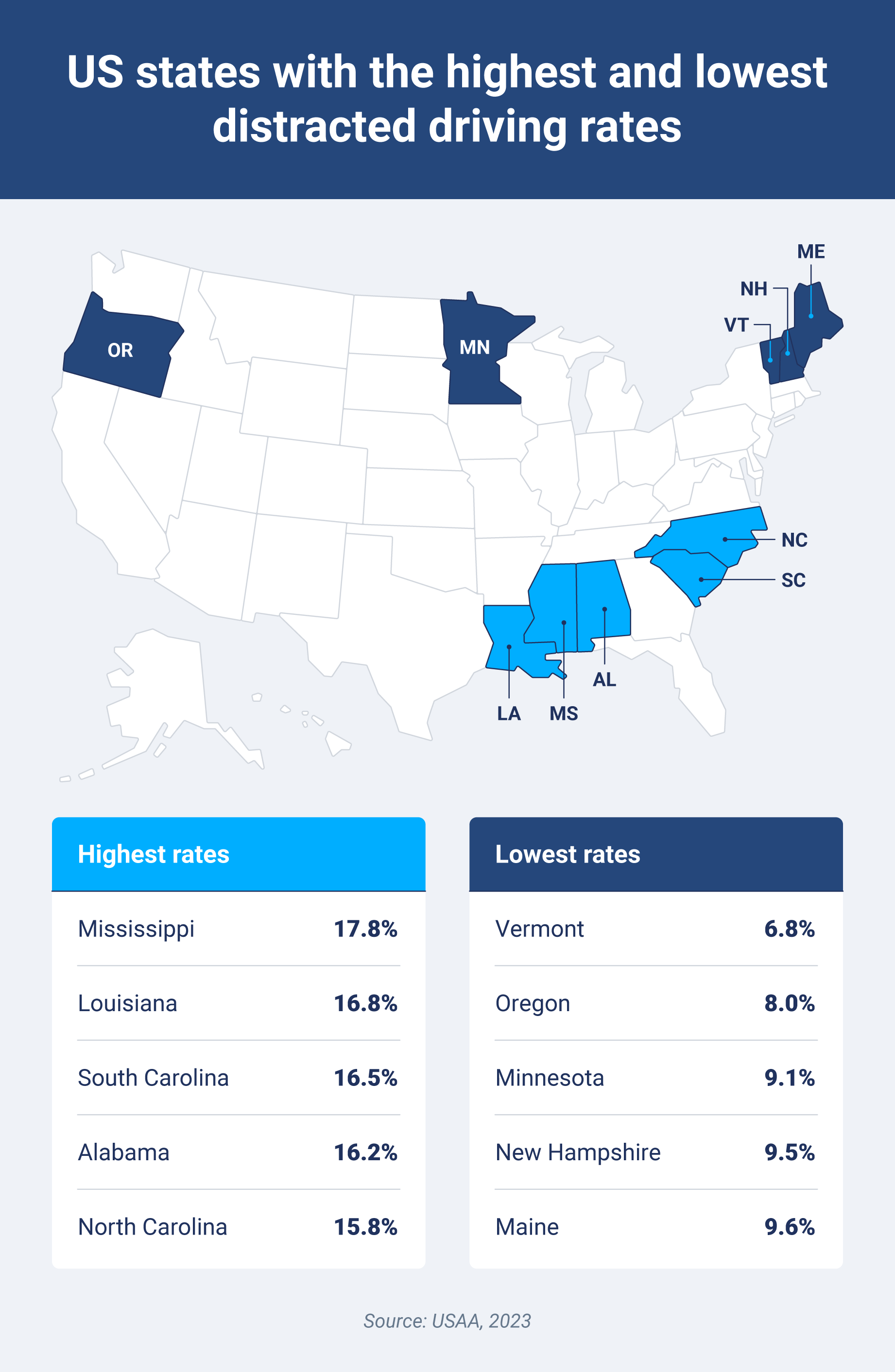
15. Mississippi is the state with the highest distracted driving rates (17.8%).7
16. Vermont has the lowest rate of distracted drivers (6.8%).7
17. Oregon has the second-lowest rate of distracted drivers (8%).7
18. In 2023, Vermont drivers spent an average of 1 minute and 14 seconds per driving hour using their phones, which is 25% less than the national average.8
19. Wisconsin and New Hampshire both exhibit 22% less distracted driving than the national average.8
20. In 2023, the states with the highest percentage of large trucks involved in fatal collisions were9:
- Wyoming: 22%
- New Mexico: 20%
- North Dakota: 18%
- Idaho: 17%
- Nebraska: 16%
21. Data from 2023 show that the states with the lowest percentage of deaths from large truck collisions are9:
- Hawaii: 2%
- District of Columbia: 2%
- Rhode Island: 3%
- New Hampshire: 5%
- Massachusetts: 5%
- Delaware: 5%
22. In 2023, these states experienced the most deaths resulting from large truck collisions9:
- Texas: 730 deaths
- California: 392 deaths
- Florida: 341 deaths
23. The fewest deaths in large truck collisions in 2023 occurred in the following states (including DC)9:
- District of Columbia: 1 death
- Hawaii: 2 deaths
- Rhode Island: 3 deaths
- Vermont: 7 deaths
Texting and driving facts
Texting is one of the most dangerous and common distracted driving examples. Despite widespread awareness and legal bans, many drivers still use their phones behind the wheel.
The texting and driving statistics below highlight how texting continues to play a role in distraction-related collisions, injuries and fatalities.
24. The percentage of drivers manipulating hand-held electronic devices has increased 36%, from 2.2% in 2014 to 3% in 2023.10
25. Data consistently showed that hand-held cell phone use was higher among female drivers than male drivers from 2005 to 2023.10
26. In 2023, drivers spent an average of 1 minute and 38 seconds per hour handling their phones while driving.8
27. Texting while driving gives the driver the same response time as a person who has drunk four beers in a single hour.11
28. Texting distracts you for long enough to travel the length of an entire football field with your eyes off the road at 55 mph.12
29. Forty-nine states, DC, Guam, the Northern Mariana Islands, Puerto Rico and the U.S. Virgin Islands ban text messaging for all drivers.13
30. In 2023, authorities reported 369 fatal traffic collisions as having cellphone use as a distraction (12% of all distraction-affected fatal traffic collisions).1
31. Collisions involving at least one driver engaged in cellphone-related activities killed 397 people in 2023.1
32. Drivers aged 25 to 34 comprised 21% of drivers in fatal traffic collisions, yet they accounted for 23% of all distracted drivers and 24% of drivers distracted by cellphones.1
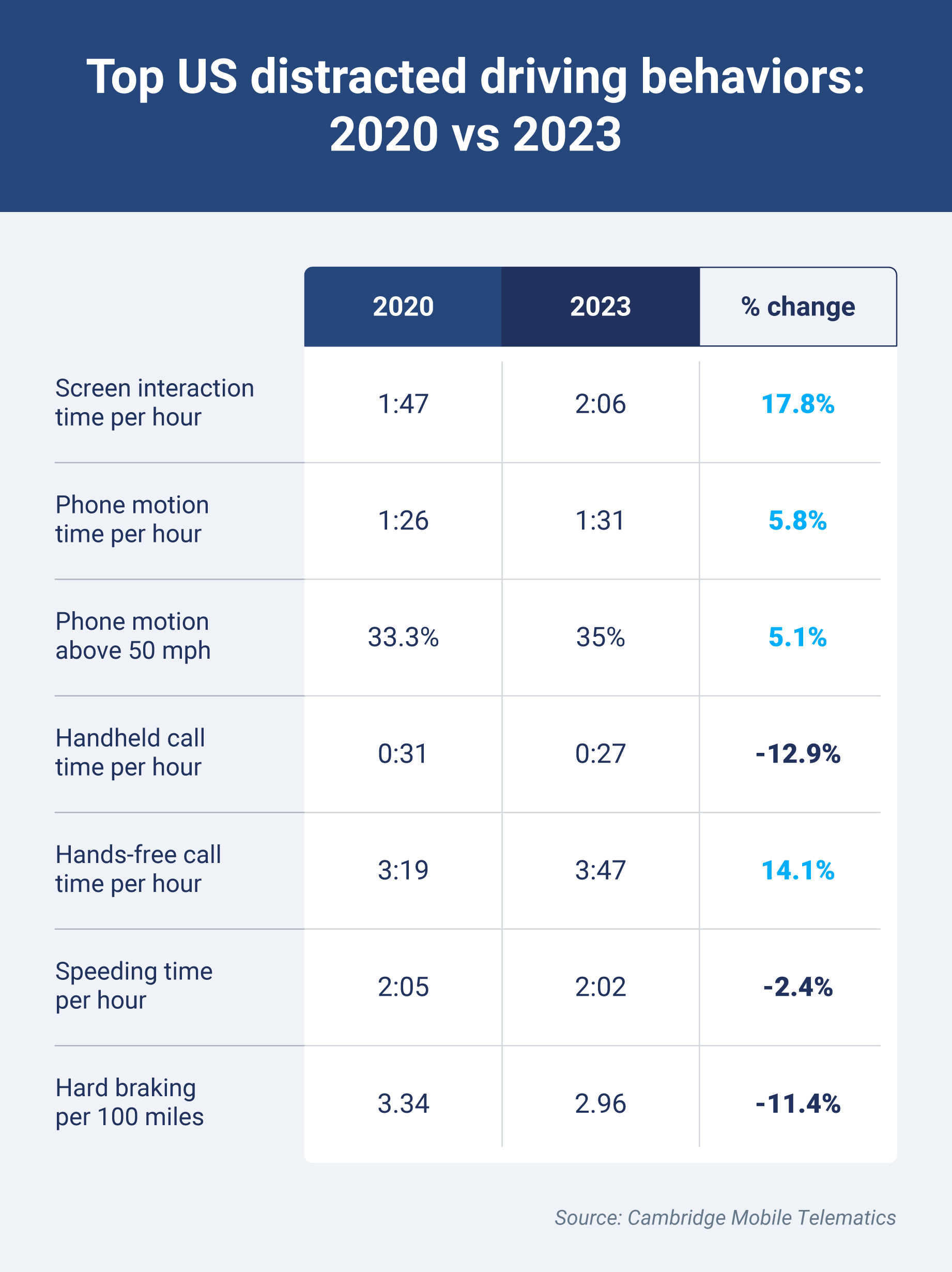
Driver distraction statistics
Distracted driving goes beyond texting. From drowsiness to digital devices, common distractions while driving can lead to serious consequences. The data below shows how distracted behaviors impact drivers.
33. Sixty percent of adults have driven drowsy.14, 26
34. At least 15% of all heavy truck collisions involve driver fatigue.14, 26
35. About 4% of adult drivers report having fallen asleep while driving.15, 26
36. A study found that 60.2% of respondents reported talking on the phone while driving.16 Additionally,
- 47% sent or received a text message.
- 40% used an app on their phone.
- 59% adjusted a GPS device or ate and drank.
- 11% applied makeup.
- 22% took a photo or video.
37. A study between 2023 and 2024 found that 40% of 490 drivers injured in motor vehicle collisions had a potentially impairing substance detected.17
38. Drivers aged 25-39, unmarried and living with children under 18, were more distracted and aggressive.18, 25
39. Most drivers perceive running red lights, rapidly switching lanes and tailgating as very or extremely dangerous driving behaviors.18, 25
40. Distracted and aggressive drivers were involved in one or more reported collisions at nearly 18%, the highest of any classification and higher than the 11% of total drivers involved in reported incidents.18, 25
41. According to a study, honking out of anger was the behavior respondents most commonly admitted to doing themselves.5
DUI statistics
Driving under the influence is one of the most dangerous forms of distracted driving, impairing judgment, reaction time and motor skills. While public awareness has grown, DUI remains a leading cause of traffic fatalities.
42. In 2022, impaired drivers (blood alcohol level greater than or equal to 0.08 g/dL) comprised over 41% of 25- to 34-year-old drivers in fatal collisions.19
43. This percentage drops to less than 30% for the 55- to 64-year-old age group and falls below 15% for drivers aged 75 and older.19
44. Montana leads the nation in drunk driving, with 8.57 drunk drivers per 100,000 licensed drivers involved in fatal collisions, and 7.14 deaths per 100,000 residents in collisions involving a drunk driver.20
45. Drunk drivers cause more than two-fifths (43.51%) of Montana's traffic deaths, the highest percentage nationwide.20
46. Over two-fifths (42.18%) of drivers have witnessed a friend or family member drive after drinking more than one alcoholic beverage, according to a survey of 10,000 licensed drivers.20
47. Drunk drivers cause over one-third (35.14%) of traffic deaths in South Dakota.20
48. In Texas, drunk drivers kill more than five people (5.14) for every 100,000 state residents in collisions.20
49. Drunk driving collisions kill or injure someone every 85 seconds.21
Distracted driving road deaths
Distracted driving continues to be a leading cause of road fatalities across North America. Understanding the scale of distracted driving deaths helps fleet managers make informed decisions about driver safety, training and technology.
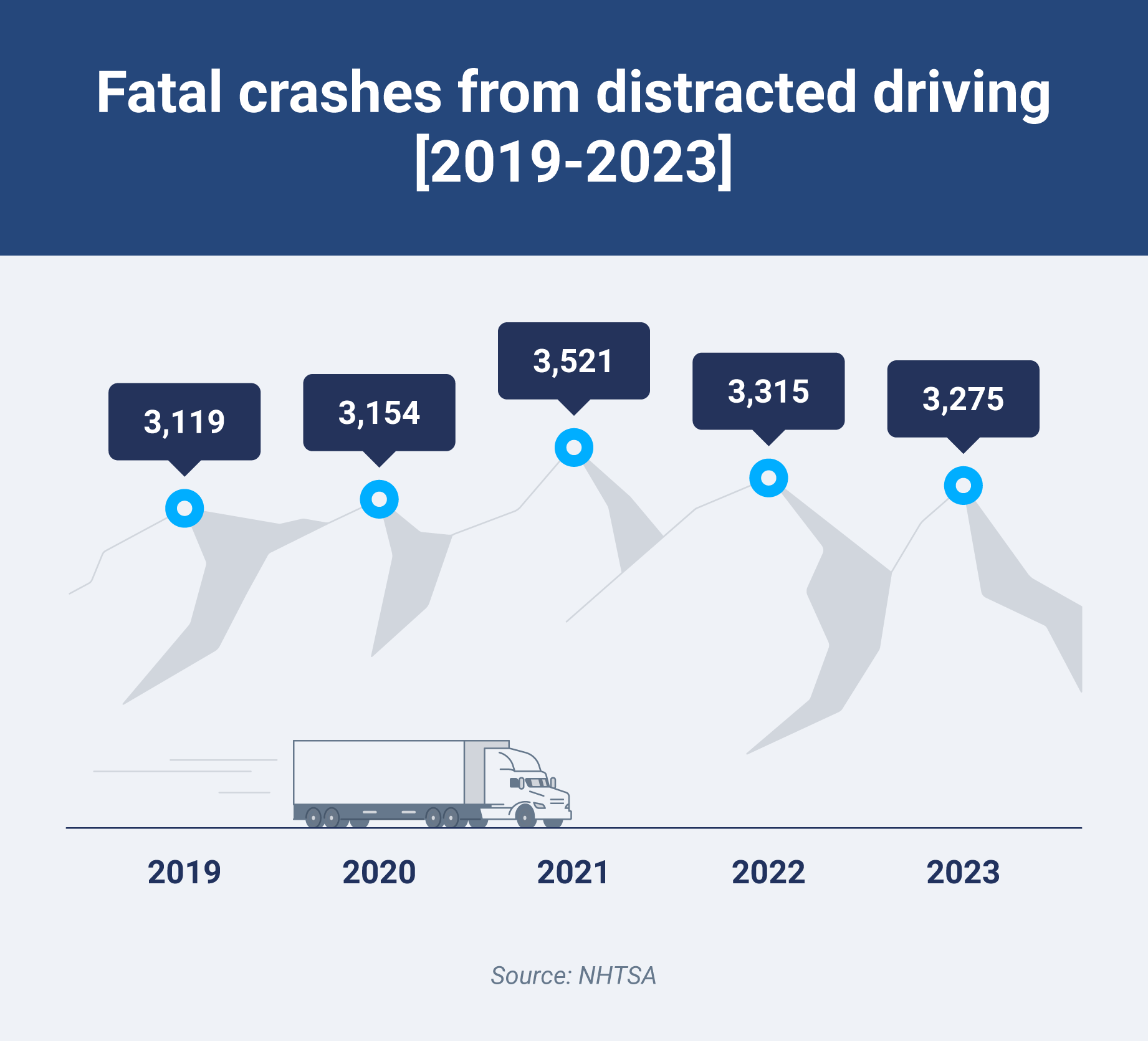
50. A 1.7% reduction in drowsy driving traffic deaths occurred in 2022, meaning 716 fewer people died compared to 2021.22, 26
51. Alcohol-impaired drivers caused 12,429 traffic deaths in 2023.
52. In 2023, alcohol-related collisions involving drivers with a BAC of .01 to .07 g/dL killed 2,117 people.23
53. On average, drunk-driving collisions killed about 11,000 people every year over the 10 years from 2014 to 2023.23
54. Thirty-four people die every day in drunk-driving collisions.23
55. In 2022, motor vehicle traffic collisions involving at least one alcohol-impaired driver caused 13,524 fatalities.24
56. Alcohol-impaired driving resulted in one fatality every 39 minutes, on average, in 2022.24
57. Each year, drowsy driving claims 633 lives, and 6 in 10 adults admit they drive drowsy.22, 26
Tips to prevent distracted driving incident
Fleets have implemented internal policies and driver safety agreements to reduce distracted driving. But relying on manual compliance isn’t enough. Technology gives fleet managers a more proactive, data-driven way to prevent distractions behind the wheel.
Distracted driving can result in collisions, downtime, higher insurance premiums and liability. Prevention helps protect your drivers, assets and bottom line.
Here are some effective tips to reduce distracted driving risk in your fleet.
Develop a distracted driving policy
Start with a clear, written policy that spells out driver responsibilities and rules on the road. It should also help set the foundation for safer driving behavior, especially when paired with training and consistent communication.
For instance, fleet safety programs offer helpful guidance for building and reinforcing policies like these. They also give fleet managers the tools to promote accountability and reduce risk across the board.
Offer ongoing driving training
A consistent driving training program keeps safety top of mind and reinforces key habits like staying focused, limiting in-cab distractions and driving with both hands on the wheel. Training also gives you the chance to introduce new tools and best practices.
Utilize driver behavior monitoring tools
Driver behavior monitoring tools can help you strengthen your training strategy and safe driving habits across your fleet.
For example, solutions like Predictive Coach detect risky behaviors and assign targeted training based on driving data. It flags actions such as speeding, hard braking, sharp acceleration and seat belt violations. These behaviors often indicate distraction and identifying them helps drivers adjust in real time.
The D2GO Driver Challenge adds a layer of motivation by using gamification to turn safe driving into a friendly competition. Drivers earn scores based on performance, see how they rank among peers and get rewarded for consistent improvement.
Continuously monitor data
Fleet data analytics plays a key role in identifying risky driving behaviors and reducing distractions on the road. By tracking telematics data over time, fleet managers can spot patterns, flag high-risk drivers and take action before incidents occur. For example, fleet data analytics make it easier to turn insights into safer outcomes.
Promote driver safety with telematics
When your focus leaves the road, the consequences can be immediate and severe. These statistics show that distracted driving remains a major issue, causing injuries, fatalities and economic losses.
However, telematics allows you to use real-time data, monitor driver behavior and reinforce safe habits with scorecards, promoting a culture of accountability.
For example, Geotab’s fleet safety software empowers you to coach drivers in real time, track vehicle performance and reduce risky behavior on the road. Powerful data insights help you prevent theft with advanced tracking, streamline maintenance using diagnostic alerts and cut fuel and insurance costs.
With Geotab, you stay in control, keeping your team safe, your assets protected and your operations running efficiently.

Sources:
- National Highway Traffic Safety Administration (NHTSA)
- Cambridge Mobile Telematics
- Lexis Nexis Risk Solutions
- AAA Foundation for Traffic Safety
- The Zebra
- Pew Research Center
- USAA; PR Newswire
- Cambridge Mobile Telematics
- National Safety Council (NSC)
- NSC
- Drive Safe Online
- NHTSA
- U.S. Department of Transportation
- National Sleep Foundation
- NSC
- The Zebra
- UC Davis Health
- AAA Foundation
- NSC
- Forbes
- Mothers Against Drunk Driving (MADD)
- NHTSA
- NHTSA
- NHTSA
- Geotab
- Geotab
Subscribe to get industry tips and insights
Frequently Asked Questions
Five percent of all drivers involved in fatal traffic crashes in 2023 were reported as distracted at the time of the crashes.1
In 2023, authorities reported cellphone use as a distraction for 369 fatal traffic crashes.1
Gen Z and Millennials (ages 16-45) account for 72% of all distracted driving violations. This makes them the largest age group responsible for these infractions.3
The Geotab Team write about company news.
Table of Contents
Subscribe to get industry tips and insights
Related posts
.png)
From the North Pole to the Highway: How AI and Predictive Insights Get Drivers Home for the Holidays
December 16, 2025
2 minute read
.jpg)
.png)
AI dash cams vs. traditional: Which delivers better fleet safety?
December 8, 2025
5 minute read

Elevating Worker Safety Through Simplicity: The OK Alone Story
December 3, 2025
2 minute read
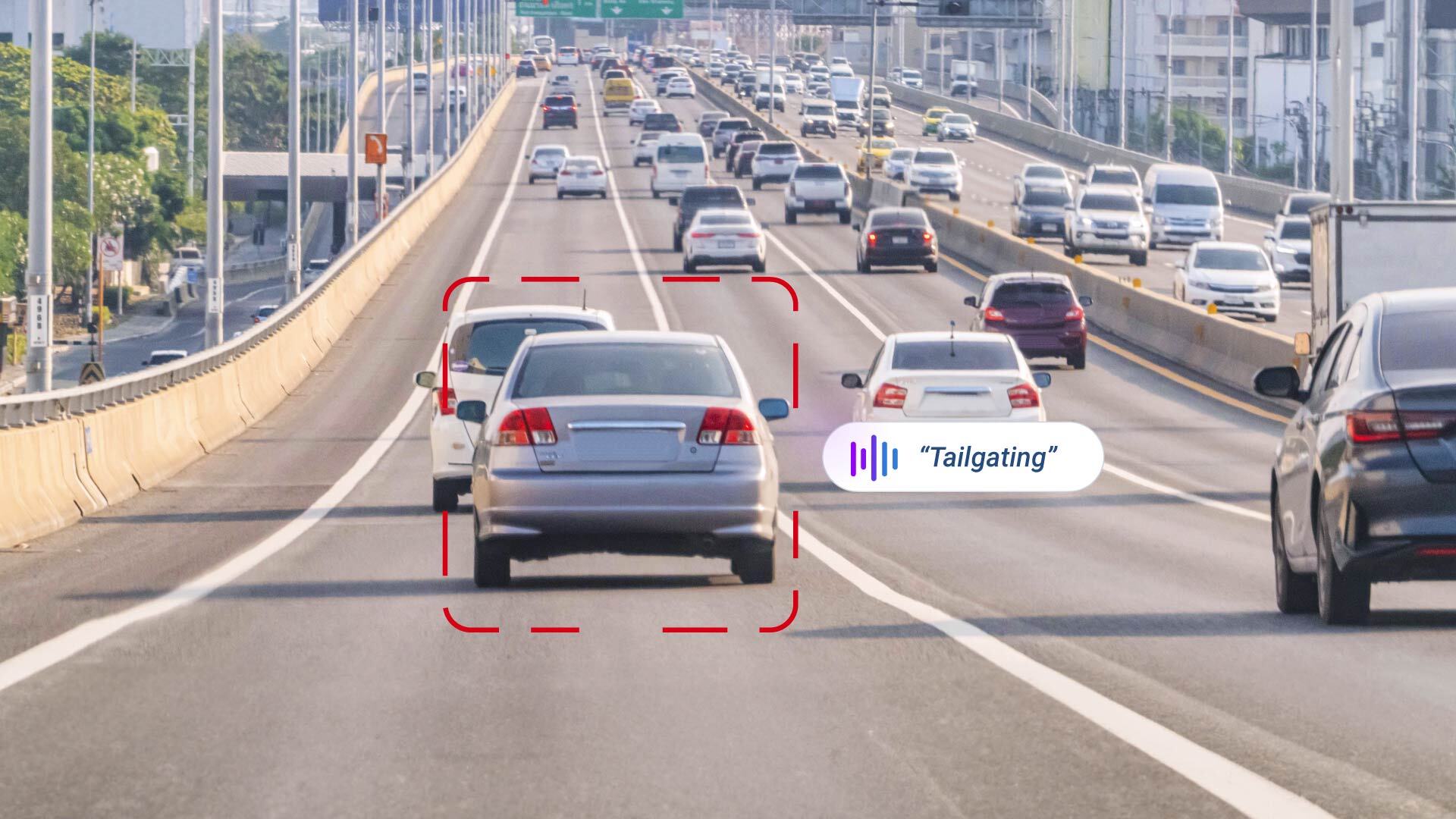
Geotab GO Focus Plus Camera Rules, Thresholds, and Event Buffers Explained
October 27, 2025
2 minute read
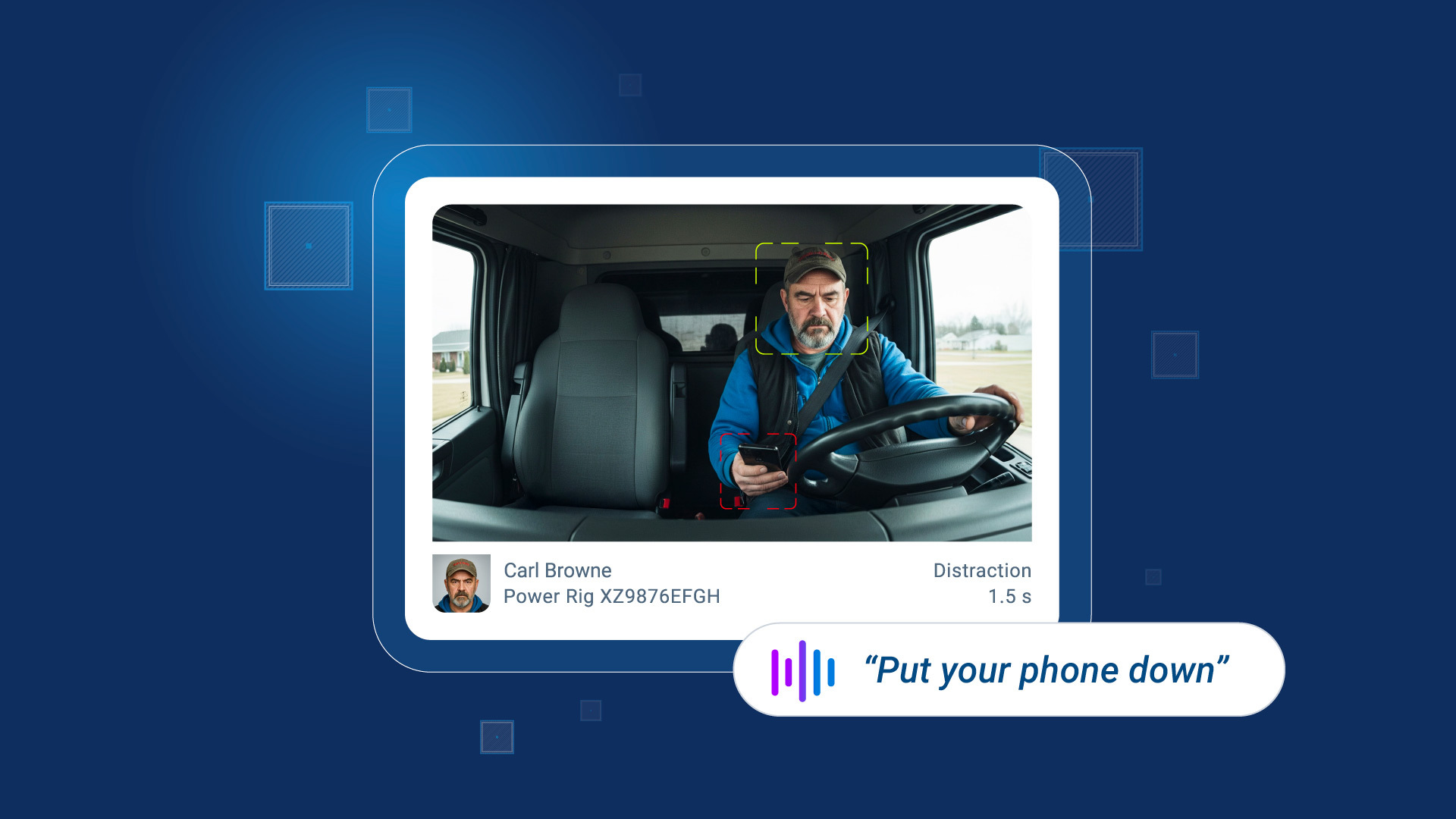
How AI dash cams help fleets tackle distracted driving and reduce collisions
October 23, 2025
4 minute read